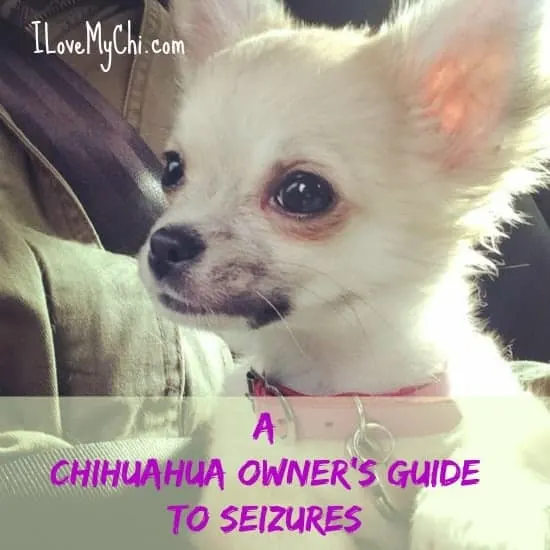As an Amazon Associate, I earn from qualifying purchases.
Seizures in dogs are definitely one of the scariest things a pet parent may have to go through.
As canine companions go, Chihuahuas are fantastic! They have sassy, super-size personalities packed into pint-size bodies – it’s easy to see why this breed is popular with dog lovers everywhere, from Coach-toting celebrities to the neighbor next door.
Unfortunately, much to the chagrin of their owners, these spunky little dogs tend to be prone to some health problems, and recurrent seizures are one of the most concerning issues that face the Chihuahua breed today.
In fact, a 2009 health survey by the Chihuahua Club of America revealed that 45% of survey participants had either bred or owned a Chihuahua with seizures of unknown origin – an alarming fact that has many lovers of the breed worried for their future.
I have gone through this myself. Although my current dogs have never had a seizure (thank God!), I went through this for almost 19 years with my beloved Terri-poo Joey.
He had them once or twice a month, so although he didn’t have to go on medication for them, they were still quite terrifying to go through, both for him and myself too.
What exactly does a dog’s seizure look like? Well, much in the same way as a human seizure might happen, a canine seizure or convulsion is a sudden excessive and uncontrollable firing of nerves in your pup’s brain.
When this happens, it produces a pattern of involuntary movements (contractions) of some muscle groups, and it can show up as odd sensations, abnormal behaviors (like staring into the distance, blinking, or repetitive movements), and a full-body convulsion, or any combination of the above.
Here’s a video of a little Chi going through a seizure:
There are usually three parts to seizure activity. The first stage, or ‘aura’ stage, is when signs of a coming seizure may be noticeable – dogs will often become restless, anxious, or clingy and might whine, tremble or hide from you.
Second is the ictal stage, which is when the actual seizure occurs. Depending on the type of seizure, you might note that your pup vocalizes, chomps, pees, or poops, as they aren’t able to control these functions at the time.
Finally, the post-ictal stage describes the time period right after the seizure. Your pup might seem confused, tired, or less responsive to you; this stage can last for mere minutes or up to a few days after the seizure.
Besides noting the signs of a seizure in your four-legged family member, it’s important to know about the causes of seizures in Chihuahuas as well. The most common reasons for seizures in this breed are:
Common Reasons for Seizures in Chihuahuas
Hypoglycemia (low blood sugar). This is especially an issue with young puppies who don’t eat frequently enough to maintain a good blood sugar level. Since Chihuahuas have a smaller number of fat cells than many other breeds, they don’t have much energy reserve to fall back on.
Hydrocephalus. Sometimes called ‘water on the brain,’ this is a condition that’s caused by an abnormal buildup of cerebrospinal fluid within the brain cavity, and it’s one that’s common to many toy breeds including Chihuahuas. The increased pressure on the brain can cause poor growth, lethargy, stumbling, and seizure activity.
Portosystemic Shunt (Liver Shunt). Another condition that’s prevalent in toy breeds, a liver shunt is a blood vessel that carries blood around the liver instead of through it. For Chihuahuas, the defect is usually one that’s congenital (present from birth). The shunt prevents the liver from removing toxins from the bloodstream and can limit a dog’s access to energy stores.
Hereditary (or idiopathic) epilepsy. Some Chihuahua breed lines are prone to hereditary seizures that don’t originate from any particular health problem.
GME This is a condition that affects the nervous system, which is more common in small dogs, though dogs of any size can develop it.
Diagnostic Testing for Chihuahuas
Determining the cause of your Chihuahua’s seizures is a task that’s best left up to your veterinarian. If your dog has had a seizure, your vet may recommend diagnostic tests to find out the underlying cause of the incident.
Diagnostic tests can include a full health history, examination (including neurological exam), blood tests, urinalysis, and stool checks. These tests are vital for determining the type of treatment needed (if necessary) for your Chihuahua’s seizure activity.
What To Do
So, what should you do if your Chihuahua has a seizure? First of all, don’t panic, and keep in mind that they’re not actually in any pain – just unconscious!
If possible, move your pup away from furniture, stairs, or water to keep him safe. You may need to hold your dog still to keep them from flopping around or trying to stand up during the seizure.
It’s a good idea to time the seizure if you can and keep track of how long it lasts, too, and, if there are multiple seizures, how long of a time period in between each seizure.
Also, use your camera function on your cell phone and take a video of the seizure while it’s in progress to show your vet.
Call your vet for advice right away if your pup’s seizure lasts longer than five minutes. Don’t put your hand or any other object in your dog’s mouth during a seizure either – dogs don’t ‘swallow their tongues, and you run the risk of being bitten accidentally; objects in their mouth during a seizure are also a choking hazard for your Chihuahua.
Stay by your little dog’s side to give them comfort and to help calm them down once they stop seizing – they’ll need some extra loving care afterward.
I know Joey always stuck to me like glue for a few hours afterward. First, I would take him out to go potty, then get him a drink of water. He was always thirsty. And then I would just hold him for a while. He seemed to need comfort.
For some dogs, seizure activity can sometimes become dangerous. You should bring your Chihuahua for emergency veterinary care immediately if you note:
- Seizures that last longer than a few minutes minutes
- Seizures that happen more than once in 24 hours
- Seizures that begin before your pup has completely recovered from the last seizure
To help your Chihuahua recover after a seizure, make sure to stay close and help them through any confusion or disorientation. Keep the room dim and quiet, and speak softly and calmly, keeping your furry friend away from hazards like stairs until they are acting like their usual self.
Some dogs may seem tired, while others bounce back as though nothing happened and are ready to play again. You can offer a small amount of water but realize that your pup may not feel like eating or drinking for a short while afterward.
For owners who adore their little sprites, their Chihuahua’s seizures can be a scary experience – it’s always difficult to watch a fur baby go through an experience like that without being able to help them. With the right care and management, though, many Chihuahuas with seizure disorders go on to live well into their senior years as happy dogs. My Joey lived to be one month shy of his 19th birthday.
I wanted to include this video, although I have no idea if it really works. If anyone tries it or has tried it, please share your results. This lady says she has found a way to halt her dog’s seizures:
If you have gone through this with your dog, feel free to share your experiences in the comments section. Have you had to put your dog on medication for seizures? How often do they have seizures?
Click to find other chihuahua health problems.
FOOTNOTE: One of the readers, Steven Bruggeman on our Facebook page, wrote this: “Not long ago my precious “SPIKE” almost passed away after multiple seizures overnight. The Emergency Vet here in Sarasota advised me to put her down. I got my Baby girl and came home. I posted the story on my FB page.
A fantastic friend told me of a vet in Mobile Alabama had proven that feeding your dog with seizures a special brand and flavor of food, and that would stop the dog from having a seizure. It is a Natural Choice, and it is fish and sweet potatoes formula. I started my spike on that three weeks ago, and since that time, she has made a full recovery where she was almost lifeless at the emergency vet.”
I have no idea if this will work for all dog seizure cases, but I thought I would add it as a possible remedy. It certainly wouldn’t hurt to try it.
Also, check the comments below as several people reported good results in stopping seizures with different tactics.
One of them is CBD oil, which has been none to help prevent or lessen the effect of seizures in some dogs (and humans too). We recommend (and use for other reasons on our elderly dog) King Kanine.
If you try CBD oil, start with the lowest dose first and be consistent with it every day for several months before you decide whether it’s helping your dog or not.
Be sure to add your recommendation if you found something that has helped your dog with their seizures.
Chihuahua Seizure FAQ
Is it common for Chihuahuas to have seizures?
45 percent of people surveyed said that they owned a Chihuahua who experienced seizures of unknown origin. It is more of a common occurrence in more than 30 dog breeds and significantly affects more than 5 percent of all dogs.
What should I do if my Chihuahua has a seizure?
First, stay calm. You can put cold water on your dog’s paws to cool him down. Avoid touching him during the seizure to avoid any accidental biting and call your vet immediately once the seizure has ended.
If the seizure is lasting more than a few minutes take your dog to the nearest vet or veterinary emergency clinic. Do not wait for the seizures to stop take them directly to the vet.
Are there foods that can cause seizures in dogs?
If your dog is prone to seizures, they should avoid eating any potentially inflammatory foods, including those foods that may trigger an allergy or sensitivity. These inflammatory foods include anything containing chemical additives, wheat, soy, corn, beef, or cow’s milk products.
Will treatment help prevent your dog from having seizures?
There are some medications your veterinarian can prescribe that can help control seizures. You should always discuss treatment with your vet because they can target your dog’s specific problem. Alternative therapies may also prove to be helpful in some cases.
Can a seizure kill a dog?
Status epilepticus is a very serious and often life-threatening situation for your dog. This occurs when your dog’s seizure lasts for more than five minutes. To help stop the seizure activity, intravenous anticonvulsants are needed, or the dog may die or suffer from irreversible brain damage because of the seizure.
How do you treat hypoglycemia in Chihuahuas?
Sometimes a sugar source like Karo syrup that is highly concentrated can help with hypoglycemia in dogs. Giving your pet a small amount of sugar to eat may help return their blood sugar levels to normal. However, you should always discuss any treatment for your Chihuahua with your veterinarian first.
Can low blood sugar cause seizures in dogs?
When your dog’s blood sugar levels drop too low, it can cause pain, seizures, loss of consciousness, and sometimes even death. Low blood sugar also ultimately affects the organs and overall brain function of your canine companion as well.
Why do Chihuahuas have seizures?
Idiopathic epilepsy is one of the most common causes of seizures in canines. This disorder is inherited, but its cause is still unknown. Other causes of canine seizures include liver disease, kidney failure, and brain trauma.


Dr. Sara Ochoa
DVM
This article has been fact-checked and approved by Dr. Sara Ochoa DVM. You can read more about her on our About page.


Tracy
Saturday 1st of March 2025
My little Chihuahua passed away back in January 2024, she had these seizures and they would only stop for a short time, then as soon as she would get up, she'd have another one. It was horrible, this went on for days and I finally made the decision to put her down. She was suffering and I couldn't stand seeing my little angel going through these horrible seizures. The vet said there really wasn't much more I could do except be there for her and with her. I miss her so much, my life is so empty without her .
Cathy Bendzunas
Saturday 1st of March 2025
I'm so sorry Tracy. That's so hard to see them go through seizures and then have to make the decision to put them down.
Lisa
Friday 24th of May 2024
I am curious about this. What are the chances that breeding the dog to be very small is causing these seizures? Could this be do to inbreeding or cross breeding?
Cathy Bendzunas
Friday 24th of May 2024
Yes, I do believe the chances are high that poor breeding practices may cause many seizure issues.
CATHERINE
Saturday 11th of May 2024
My Lucky gets seizures only when the weather gets really hot. It's very scary. I used a cool wet towel and a fan. I found this helps him. I comfort him. After that he's fine. He was a Chihuahua from my friend. He was inbread. That's the only thing I can sum it up too. I will take a video of my Lucky next time it gets too hot and show his veterinarian ASAP. Praying for all the other fur babies and the owners that have this experience.
Cathy Bendzunas
Saturday 11th of May 2024
Poor little guy. Yes, being inbred could certainly be why he has the seizures.
pamela cassise
Monday 26th of February 2024
I had a chihuahua named Frankie. At 9 yrs old she started having this tremendously violent seizure, flopping off the bed, against the wall, I tried to steady her and hold her so she would not fall off the bed, but her seizures were so violent and lasted for 15-20 min. I took her immediately to the Vet. The assistant and Vet told me she must go into the hospital or she will die. I only had $900 to my name and they wanted money up front, about $3000. I couldn't get money, and they would not let me have her, telling me to call my parents, friends...I am bi-polar so I went into a paranoid panic and screamed to give her to me. The vet told me she would not survive if I took her home. I was freaking out and she never woke up after 10 hours. She was barely breathing, tongue hung out, so I thought she was going to die. I didn't want her to suffer so I took her to another hospital and told them to put her down. Now, I read this, and realize that I killed my dog. She may not have been dying. I am devastated. I killed my dog, now I want to kill that vet by manipulating me to get me to pay. I will never get over killing her. This is the worst day of my life because if I would have known Chihuahua's have seizures, that they will recover and I put her down at 9 yrs. Old. Oh, my God, I can't believe I killed my dog.
Cathy Bendzunas
Tuesday 27th of February 2024
Please don't beat yourself up Pamela. If the seizures were lasting 15-20 minutes, she most likely would have died anyway or would have been brain dead if she survived. That predatory vet practice should be ashamed of themselves for the way they handled it.
Kathy
Saturday 20th of January 2024
My Chihuahua has had seizures since she was around one, vet put her on Kepra to control it. Vet also gave me Valium to put in her rectum to get her out of an active seizure, which has always been successful. Today she had a seizure that wouldn’t stop despite the Valium, had to bring her to Blue Pearl emergence facility that was 45 minutes away, she was seizing the whole way. They gave her iv’s with seizure meds and other therapies. They are keeping her there to continue to help her, she did come out of the seizure and was looking at me, but was unstable they said it was because of the meds, I’m waiting for an update. She is 5 years old. Anyone have similar stories?
Cathy Bendzunas
Saturday 20th of January 2024
Oh wow Kathy! Keep us updated about her condition.